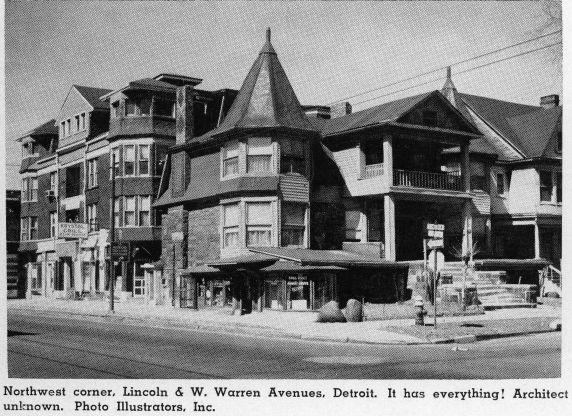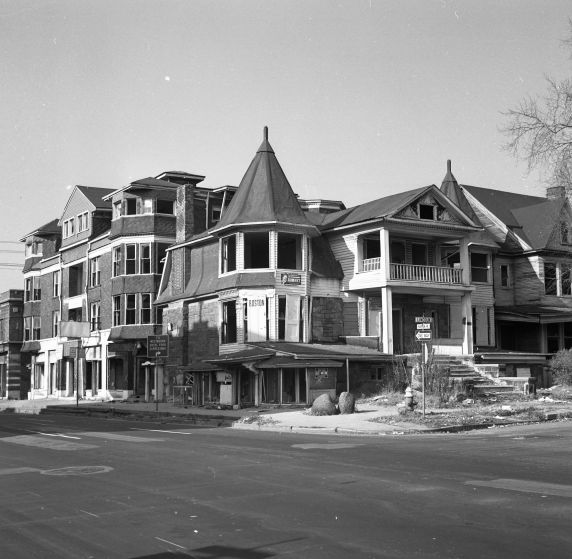University City
In the Winter 2013 semester, the Reuther Library worked with students in the Graduate Certificate in Archival Administration program at the Wayne State School of Library and Information Science to produce a series of student-written, guest blog posts.
Kelly Kietur is a student at Wayne State University working towards her Archival Administration Certificate.
The tightly packed Wayne State campus is a familiar sight to students, but at one point in time, Wayne State had ambitious expansion plans in mind. The controversial University City project, developed in the early 1960s, was a plan to build a university community with housing, shopping, and schools on 300 acres of land around Wayne State’s campus.
The original University City plan went south to Canfield, north to Interstate 94, west to Grand River and 14th streets, and east to Woodward. The project was to be completed in five phases, with Wayne State only directly involved in the first two. Phase one consisted of the land bounded by the Lodge Freeway to the east, Interstate 94 to the north, Trumbull to the west, and Warren to the south; phase two went north to Warren, south to Canfield, west to Trumbull, east to Woodward between Warren and Forest, and east to Third from Forest to Canfield; phase three went north to Warren, east to 12th, west to 14th/Grand River, and south to Canfield; phase four went north to Warren, east to Trumbull, west to 12th, and south to Canfield; and phase five went north to Interstate 94, east to Trumbull, west to 12th, and south to Warren. The land located directly west of the Lodge Freeway would be used for student housing, married student residences, and recreational facilities. North of Warren was earmarked for academic and research facilities and dormitories, while the area south of Warren would contain 1500 residential units for faculty, staff, and married couples, as well as areas for shopping. The area west of Trumbull was to be used for private housing, commercial districts, and public schools.
Acquiring the land needed to begin Phase I went at a slow pace, and Wayne State did not own all the land until December 1966. Wayne State had a poor relationship with members of the heavily African-American neighborhood west of the Lodge Freeway who felt that Wayne State was an arrogant, insensitive, and racist institution. Despite this, there was little opposition to the University City project until the formation of the West Central Organization in June 1965. The West Central Organization sought to help poor people in the city gain control over their neighborhoods and to protect the rights of people dislocated by freeway construction and urban renewal.
The West Central Organization disputed Wayne State’s claim that the neighborhood around the university was blighted, calling it “blight by announcement.” They also claimed that Wayne State had no firm plans for the parcels of land that they were attempting to acquire and that the land would sit vacant for years. The neighborhood residents claimed that the city performed a windshield survey – observations made while driving through the neighborhoods – to find superficial problems with houses and used these observations as justification to cut down on city services such as garbage pickup, further contributing to the neighborhood’s decline. Residents alleged that the city of Detroit bought up personal property but refused to board buildings up, allowing vandals to enter and gut empty structures, and that the city was unconcerned with this as they were planning to change the neighborhood. The University City I and II parcels comprised 80% of Wayne State’s off-campus housing, which led some residents to believe that Wayne State wanted to force students to live in more expensive on-campus housing. Women under 21 who were not living with parents or close relatives were required to live in the Helen Newberry Joy dormitory, and University City opponents cited this requirement as evidence of Wayne State forcing on-campus living and that most students did not care to live on campus.
During this time there were campus organizations that were sympathetic to the West Central Organization, such as the Student Organizations for University Reform, founded in February 1966. From 1967 to 1975 the South End, Wayne State’s student newspaper, became increasingly radical and supportive of organizations like the West Central Organization that opposed urban renewal plans and practices.
Wayne State revised its University City plan, but the West Central Organization was not willing to accept it. The West Central Organization eventually forced the Detroit Housing Commission to use existing federal programs to build low- and moderate-income housing near areas of urban renewal, and in 1965 the state legislature to pay relocation expenses for displaced residents.
Detroit’s environment went through a marked change in the 1960s and by the end of the decade Wayne State was operating in a much different environment. The civil unrest of 1967, coupled with the departure of Jerome Cavanagh as mayor of Detroit, meant that Wayne State received less compliance from the city in its expansion plans. While Wayne State planned to undertake the second phase of the University City project, the university was no longer able to make purchases in the University City II parcel after 1970, meaning that the only significant real estate acquisition for University City was the University City I parcel, which was eventually used for Adams Field and the Matthaei Physical Education Center.
For additional information about the University City project, please consult the Ruth Tenney Papers, the Carl W. Almblad Papers, and the David Cohen Papers, as well as Charles Hyde’s manuscript, The Physical Development History of the Campus of Wayne State University, Detroit, Michigan. View more images of the University City neighborhood in the Virtual Motor City.
Additional Source:
A Place of Light: The History of Wayne State University by Leslie Hanawalt
- Public Relations Team's blog
- Login to post comments
- Printer-friendly version



 Reddit
Reddit Facebook
Facebook LinkedIn
LinkedIn